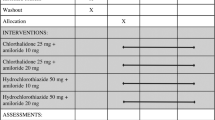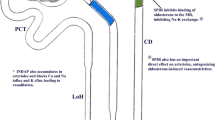Summary
The role of acetylator phenotype in determining the response to hydralazine when it was added to diuretic and β-blocker at doses not exceeding 200 mg daily was examined in 57 hypertensive patients. 81% of rapid acetylators needed 200 mg hydralazine daily compared to 38% of slow acetylators (p<0.01). Despite higher doses of hydralazine the blood pressure was controlled in only 27% of rapid acetylators compared to 65% of slow acetylators (p<0.02). The relation of acetylator phenotype to blood pressure response was statistically independent of initial blood pressure, age, sex, body weight and serum creatinine (p<0.005). Current recommendations on hydralazine dosage are unsatisfactory for the 40% of hypertensive patients who are rapid acetylators. We suggest measurement of the acetylator phenotype in patients who respond incompletely to 200 mg hydralazine daily. About 70% of these patients will be rapid acetylators in whom the dose of hydralazine can be increased safely.
Similar content being viewed by others
References
Ramsay LE (1980) Diuretic and β-blocker in hypertension — then what? J R Coll Physicians Lond 14: 249–253
Ludden TM, McNay JL, Shepherd AMM, Lin MS (1982) Clinical pharmacokinetics of hydralazine. Clin Pharmacokinet 7: 185–205
Zacest R, Koch-Weser J (1972) Relation of hydralazine plasma concentration to dosage and hypotensive action. Clin Pharmacol Ther 13: 420–425
Silas JH, Ramsay LE, Freestone S (1982) Hydralazine once daily in hypertension. Br Med J 284: 1602–1604
Hunyor SN (1975) Hydralazine and β-blocker in refractory hypertension with characterization of acetylator phenotype. Aust NZ J Med 5: 530–536
Vandenburg MJ, Wright P, Holmes J, Rogers HJ, Ahmad RA (1982) The hypotensive response to hydralazine, in triple therapy, is not related to acetylator phenotype. Br J Clin Pharmacol 1982; 13: 747–750
Kalowski S, Hua ASP, Whitworth JA, Kincaid-Smith P (1979) Hydralazine with beta-blockade and diuretic in the treatment of hypertension. Med J Aust 12: 439–440
Bing RF, Russel GI, Thurston H, Swales JD (1980) Hydralazine in hypertension: is there a safe dose? Br Med J 281: 353–4
Winchester JF, Ward DM, McKillop JH, Kennedy AC (1976) Hydralazine or phentolamine as adjuncts to beta-adrenoceptor blockade/thiazide therapy in hypertension. Br J Clin Pharmacol 3: 863–7
Wilcox RG, Mitchell JRA (1977) Contribution of atenolol, bendrofluazide and hydralazine to management of severe hypertension. Br Med J 2: 547–50
Vree TB, Hebster YA, Baars AM, Damsona JE, van Derkleijh E (1978) Determination of trimethoprim and sulphamethazole (co-trimoxazole) in body fluids by means of high performance liquid chromatography. J Chromatogr 146: 103–12
Baker, RJ, Nelder JA (1978) The GLIM system. Generalised Linear Interactive Modelling Manual. NAG Oxford
Perry HM (1973) Late toxicity to hydralazine resembling systemic lupus erythematosus or rheumatoid arthritis. Am J Med 54: 58–72
Ramsay LE (1982) Hypertension. In: Wilkes E (ed) Long-term prescribing. Faber and Faber, London, pp. 18–38
McAreavey D, Ramsay LE, Latham L, Lorimer AR, McLaren D, Reid JL, Robertson JIS, Robertson MP, Weir RJ The “third drug” trial: a comparative study of antihypertensive agents added to treatment when blood pressure is uncontrolled by a beta-blocker plus thiazide diuretic. Br Med J (in press)
Author information
Authors and Affiliations
Rights and permissions
About this article
Cite this article
Ramsay, L.E., Silas, J.H., Ollerenshaw, J.D. et al. Should the acetylator phenotype be determined when prescribing hydralazine for hypertension?. Eur J Clin Pharmacol 26, 39–42 (1984). https://doi.org/10.1007/BF00546706
Received:
Accepted:
Issue Date:
DOI: https://doi.org/10.1007/BF00546706




